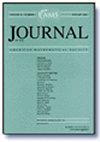Essential surfaces in graph pairs
IF 3.2
1区 数学
Q1 MATHEMATICS
引用次数: 27
Abstract
A well-known question of Gromov asks whether every one-ended hyperbolic group Γ \Gamma has a surface subgroup. We give a positive answer when Γ \Gamma is the fundamental group of a graph of free groups with cyclic edge groups. As a result, Gromov’s question is reduced (modulo a technical assumption on 2-torsion) to the case when Γ \Gamma is rigid. We also find surface subgroups in limit groups. It follows that a limit group with the same profinite completion as a free group must in fact be free, which answers a question of Remeslennikov in this case.图对中的本质曲面
Gromov的一个著名问题是,是否每个单端双曲群Γ\Gamma都有一个曲面子群。当Γ\Gamma是具有循环边群的自由群图的基群时,我们给出了一个肯定的答案。因此,Gromov的问题被简化为Γ\Gamma是刚性的情况(模关于2-扭转的技术假设)。我们还发现极限群中的表面子群。因此,与自由群具有相同profinite完备的极限群实际上必须是自由的,这回答了在这种情况下Remeslennikov的一个问题。
本文章由计算机程序翻译,如有差异,请以英文原文为准。
求助全文
约1分钟内获得全文
求助全文
来源期刊
CiteScore
7.60
自引率
0.00%
发文量
14
审稿时长
>12 weeks
期刊介绍:
All articles submitted to this journal are peer-reviewed. The AMS has a single blind peer-review process in which the reviewers know who the authors of the manuscript are, but the authors do not have access to the information on who the peer reviewers are.
This journal is devoted to research articles of the highest quality in all areas of pure and applied mathematics.

 求助内容:
求助内容: 应助结果提醒方式:
应助结果提醒方式:


